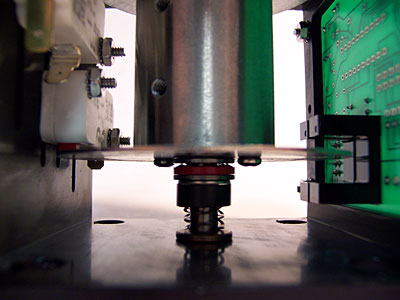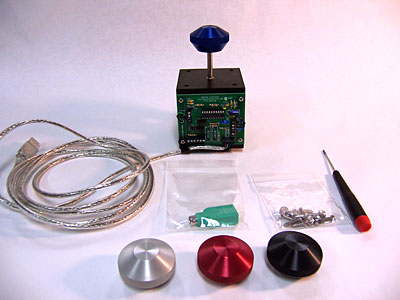



The Apache Controls Blackhawk Spinner
Review by Kevin Steele
First Posted July 2006
Introduction
Many long time RetroBlast readers will remember the “MAME Spinner Roundup Review,” which was the first group product review that I wrote for this site. It included seven spinners, ranging from the classic Tempest spinner all the way up to the then brand-new SlikStik Tornado spinner. I spun, I tested, I played.
You’d think that I would be jaded about new spinners by now. After all, is there really that much different between them? Well, I’m excited about a spinner again: the new Blackhawk spinner by Apache Controls.

The Apache Controls Blackhawk Up/Down Spinner
What’s So Exciting?
The Apache Controls Blackhawk is a brand new spinner from a brand new company. Building on the past, the Blackhawk takes nearly every great feature I’ve ever seen in previous spinners and consolidates them all into one fantastic spinner design, and then throws in some unique design elements that I’ve never seen before. In many ways, this is what I would consider to be the “ultimate” arcade spinner.
Looking It Over
From the moment I opened the box I knew I was in for a great experience. The spinner was excellently packed, sealed in a static-protection bag and well padded. The spinner comes with a free 5/64” hex driver to mount the spinner knob. The spinner even comes standard with all the mounting hardware (read: screws, nuts, and bolts) that you may need to mount it.
Even at first sight you’ll realize that this is one solidly-constructed spinner. The black anodized aluminum box frame is as sturdy as it looks, and everything from the press-fit brass bearings to the flywheel and encoder board speak of the attention to detail that went into designing this spinner.
One of the most unique elements of the Blackhawk spinner is the up/down functionality: you can pull up or push down on this spinner as you rotate it, activating microswitches above or below. While this type of up/down spinner controller has only been used in one arcade game (Discs of Tron), it proves to be a surprisingly versatile addition to a spinner. In fact, you can easily adapt this type of up/down functionality to a large number of games, from launching the ball in Arkanoid to an emergency “Super Zap” in Tempest.
The mechanism for the up/down switches is a unique and elegantly simple design. There are two discs on spinner: one above the flywheel, and one below (The bottom disc is actually the encoder wheel, as well!). These discs, combined with the flywheel, form a sort of “spindle” on the main shaft, which is supported on both the top and bottom by compression springs. The extended discs of this spindle activate microswitches when the spinner shaft is pulled or pushed.

Closeup of the "Spindle"
The design is surprisingly effective, and the first time I’ve seen microswitches used in this manner (the original Discs of Tron spinner and the Oscar Controls remake both used leaf switches). The one drawback to the design, though, is that the microswitches do add noticeable resistance to the spinner if you try and turn it while pushing or pulling, much more so than the leaf-switch spinner design does. There’s even a slight “squeaking” or grinding sound, and although it’s not a major flaw, it is noticeable.

Lower spring assembly and spinner optics
Installation is a cinch: as with other spinner designs, all that is required is one small hole in the panel for the shaft, and four screws to mount for a wooden control panel, or four bolts for a metal panel. The installation footprint is fairly compact as well: 3.25" x 3.25" x 3".
Encoding It All
The Blackhawk spinner comes with an attached encoder, available as a full-fledged encoder (the “primary” configuration), or a optics-only version (the “secondary” configuration).

The Blackhawk Encoder Board
The “primary” encoder configuration includes a USB encoder that is as full-featured as the spinner itself (it also supports PS/2 use with an optional adapter). In addition to supporting three axis (enough for both a spinner and a trackball), the encoder also supports up to five mouse buttons. For some control panel designs, this encoder may be all you need.
The board is very cleanly laid out, with components and jumpers clearly labeled. The attached 8-foot USB cable is tightly secured, as well. It’s a nice “all-in-one” design with the encoder optics on the back of the board, making the Blackhawk a nice plug-and-play spinner solution. The spinner is instantly recognized as a mouse by the computer, and no drivers are required.
Performance Testing
Okay, so it looks pretty. How’s is it with games? After all, you’ll never see the guts of this spinner once it’s installed, but if the gameplay stinks, you’ll curse it every time you fire up your cabinet. Well, I’m happy to report that this is one of the best performing spinners I’ve had the pleasure of using.
Right out of the box it worked perfectly with every MAME game I threw at it, and even better, the sensitivity and responsiveness of the spinner felt spot-on. I didn’t have to adjust a single game, a rarity when I’ve done spinner testing. The spinner is a 48-tooth design, which means that it theoretically has less sensitivity than some of the other spinners on the market, but I saw nothing during gameplay that indicated this. In fact, I got some of my highest scores on Tempest ever with this spinner.
Some of the credit for my new high scores also has to go to the exceptional knob: offered as an optional item, Apache Controls’ reproduction DOT knob is a wonder to grip. Available in four anodized colors, the machined aluminum knob felt great in my hand, with easy to grip knurling on the sides and a diameter that was very comfortable to grip.
About the only negative I can mention about this spinner’s performance during gameplay is the aforementioned friction and grinding feel when turning the spinner while pulling or pushing. If you’ll pardon the pun, it rubbed me the wrong way, but considering that you’ll probably only be pulling and pushing while turning in a single game, I suppose can forgive the design this one idiosyncrasy, especially since it wasn't a huge problem anyway. The switch sensitivity can be set by adjusting the screws holding the switches in place.

Switch Sensitivity Can be Adjusted on the Side of the Spinner
One humorous thing I saw was with this spinner was what I would call the first "perfect backspin" that I have ever seen in spinner testing. Basically, when you really crank up MAME's spinner sensitivity settings, the Blackhawk, like all other spinners, will eventually exhibit backspin. However, in the case of the Blackhawk, the backspin was perfectly consistent: spin left, the cursor will go right. Spin right, the cursor goes left. No stopping, back-tracking, or stuttering — it just reversed orientation. A perfect backspin, so to speak.
To wrap up the testing, I dusted off the old “MAME Spinner Comparison Chart” and added the Blackhawk. It holds up quite nicely compared to the other spinners in nearly every category:
MAME Spinner Comparison Chart |
||||||||
|
Tron Spinner |
Oscar Pro |
Oscar Push/Pull |
Oscar M.3 |
Oscar Vortex | SlikStik Tornado |
Tempest Spinner | Apache Blackhawk |
Spin time (secs) |
3 | 7 | 4/3* | 5 | 10 | 3 min. 5 sec. | 5 | 30 |
Spin start weight |
4 | 4 | 4 | 2 | 4 | 2 | 3 | 3 |
Direction change weight |
4.5 | 4 | 3 | 3 | 4 | 2 | 3 | 3 |
Quick stop from spin |
4 | 2 | 4 | 3 | 2 | 2 | 3 | 3 |
Backspin level |
50 | 40 | 40 | 70 | 30 | 55 | 25 | 65 |
Wobble |
3 | 0 | 3/1* | 0 | 0 | 0 | 1 | 0 |
Design |
3 | 4 | 3 | 3 | 5 | 5 | 4 | 5 |
Installation |
n/a | 4 | 3 | 2/4** | 5 | 5 | 4 | 5 |
* With Optional Sleeve Bearing Installed
**With Optional Metal Mounting Plate
Conclusions
A review is a mix of objective facts and personal opinion. In this case, I started the review with a wonderful first-impression “vibe” and the spinner never disappointed my high expectations. The Apache Controls Blackhawk spinner is priced at $129 (the knob is an additional $9.99 when purchased with the spinner), which is relatively pricey compared to other available spinners, but it is definitely a top performer, exceptionally well designed and built, and currently the only up/down spinner on the market. It’s also backed up by a 90-day full refund if you’re not completely satisfied.

Blackhawk Spinner, Optional Knobs, and Other Accessories
If you want the ultimate arcade spinner, the Blackhawk is certainly worth the price of admission. Recommended by RetroBlast.

Pros
- Anodized aluminum box frame
- Full-featured USB encoder
- Adjustable up/down switches
- Accurate, responsive gameplay
Cons
- Friction from up/down microswitches
- Relatively low tooth count on encoder wheel
- Costly
